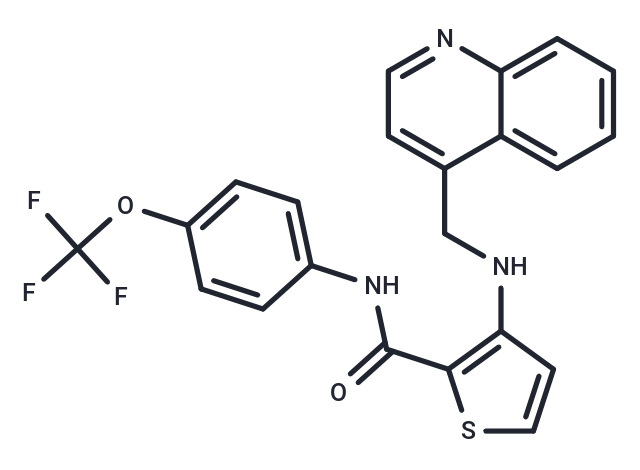Shopping Cart
- Remove All
 Your shopping cart is currently empty
Your shopping cart is currently empty

OSI-930, an orally active inhibitor of c-Kit and the vascular endothelial growth factor receptor-2 (VEGFR-2), targets cancer cell proliferation and blood vessel growth (angiogenesis) in tumors.

| Pack Size | Price | Availability | Quantity |
|---|---|---|---|
| 1 mg | $47 | In Stock | |
| 5 mg | $94 | In Stock | |
| 10 mg | $147 | In Stock | |
| 25 mg | $276 | In Stock | |
| 50 mg | $446 | In Stock | |
| 100 mg | $645 | In Stock | |
| 200 mg | $918 | In Stock | |
| 1 mL x 10 mM (in DMSO) | $98 | In Stock |
| Description | OSI-930, an orally active inhibitor of c-Kit and the vascular endothelial growth factor receptor-2 (VEGFR-2), targets cancer cell proliferation and blood vessel growth (angiogenesis) in tumors. |
| Targets&IC50 | FLK1:8 nM, CSF1R:15 nM, KDR:9 nM, C-Raf:41 nM, Lck:22 nM |
| In vitro | In HMC-1 cell line (IC50=14 nM), OSI-930 inhibited cell proliferation and induced apoptosis.OSI-930 was able to inhibit a variety of recombinant receptor tyrosine kinases, Kit (IC50=80 nM), KDR (IC50=9 nM), Flt (IC50=8 nM), CSF-1R (IC50=15 nM), c- Raf (IC50=41 nM) and Lck (IC50=22 nM). |
| In vivo | In HMC-1 cell line (IC50=14 nM), OSI-930 inhibited cell proliferation and induced apoptosis.OSI-930 was able to inhibit a variety of recombinant receptor tyrosine kinases, Kit (IC50=80 nM), KDR (IC50=9 nM), Flt (IC50=8 nM), CSF-1R (IC50=15 nM), c- Raf (IC50=41 nM) and Lck (IC50=22 nM). |
| Kinase Assay | Protein kinase assays : Protein kinase assays are either done in-house by ELISA-based assay methods (Kit, KDR, PDGFRα, and PDGFRβ) or by a radiometric method. In-house ELISA assays used poly(Glu:Tyr) as the substrate bound to the surface of 96-well assay plates; phosphorylation is then detected using an antiphosphotyrosine antibody conjugated to HRP. The bound antibody is then quantitated using ABTS as the peroxidase substrate by measuring the absorbance at 405/490 nm. All assays uses purified recombinant kinase catalytic domains that are either expressed in insect cells or in bacteria. The Kit and EGFR protein used for in-house assays are prepared internally; other enzymes are obtained. Recombinant Kit protein is expressed as an NH2-terminal glutathione S-transferase fusion protein in insect cells and is initially purified as a nonphosphorylated (nonactivated) enzyme with a relatively high Km for ATP (400 μM). In some assays, an activated (tyrosine phosphorylated) form of the enzyme is prepared by incubation with 1 mM ATP for 1 hour at 30 °C. The phosphorylated protein is then passed through a desalting column to remove the majority of the ATP and stored at ?80 °C in buffer containing 50% glycerol. The resultant preparation has a considerably higher specific activity and a lower Km for ATP (25 μM) than the initial nonphosphorylated preparation. The inhibition of Kit autophosphorylation by OSI-930 is assayed by incubation of the nonphosphorylated enzyme at 30 °C in the presence of 200 μM ATP and various concentrations of OSI-930. The reaction is stopped by removal of aliquots into SDS-PAGE sample buffer followed by heating to 100 °C for 5 minutes. The degree of phosphorylation of Kit is then determined by immunoblotting for both total Kit and phosphorylated Kit. |
| Cell Research | For assays of cell proliferation and apoptosis, cells are seeded into 96-well plates and incubated for 2 to 3 days in the presence of OSI-930 at various concentrations. Inhibition of cell growth is determined by luminescent quantitation of the intracellular ATP content using CellTiterGlo. Induction of caspase-dependent apoptosis by OSI-930 is quantitated by an enzymatic caspase 3/7 assay. Inhibition of angiogenesis by OSI-930 is monitored using the rat aortic ring endothelial sprout outgrowth assay. Sections of aorta are prepared from CO2-euthanized male rats and cultured in vitro in a collagen matrix in the presence or absence of OSI-930. The collagen matrix is prepared from type 1 rat tail collagen solubilized in 0.1% acetic acid at 3 mg/mL, which is combined with 0.125 volume collagen buffer (0.05 N NaOH, 200 mM HEPES, 260 mM NaHCO3), 0.125 volume of medium 199, 0.0125 volume of 1 M NaOH, and 1% GlutaMax. Aortic rings are embedded in 0.4 mL of this matrix in six-well plates, to which 0.5 mL endothelial basal medium and the appropriate amount of OSI-930 is added; the rings are then incubated for 10 days and the resultant angiogenic sprout outgrowth is digitally quantitated from images by measurement of the sprout-containing area within a series of concentric rings around the aortic tissue area.(Only for Reference) |
| Alias | OSI 930 |
| Molecular Weight | 443.44 |
| Formula | C22H16F3N3O2S |
| Cas No. | 728033-96-3 |
| Smiles | FC(F)(F)Oc1ccc(NC(=O)c2sccc2NCc2ccnc3ccccc23)cc1 |
| Relative Density. | 1.450 g/cm3 |
| Storage | Powder: -20°C for 3 years | In solvent: -80°C for 1 year | Shipping with blue ice. | ||||||||||||||||||||||||||||||||||||||||
| Solubility Information | DMSO: 82 mg/mL (184.92 mM), Sonication is recommended. Ethanol: 3 mg/mL (6.77 mM), Sonication is recommended. | ||||||||||||||||||||||||||||||||||||||||
Solution Preparation Table | |||||||||||||||||||||||||||||||||||||||||
Ethanol/DMSO
DMSO
| |||||||||||||||||||||||||||||||||||||||||

Copyright © 2015-2025 TargetMol Chemicals Inc. All Rights Reserved.